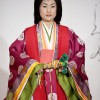
The Heian period is a period of Japanese history from 794 to 1185 which is famous for its cultural and intellectual achievements. This historical period is considered the golden age of Japanese court due to the art, literature, and poetry produced by its members and also because of the heavy emphasis placed on beauty and elegance.
Women had a very important role to play in the social and interpersonal workings of the Heian court, and even exercised a surprising degree of freedom and autonomy in a society defined by formalities. Here are a few of the personal relationships in which a woman of the Heian court was likely to find herself.
Women in Heian Court Marriages
Heian court marriages were arranged and often polygamous. A man could have several wives, though a woman could have only one husband. There was no formal marriage ceremony, rather the details of the marriage were privately agreed upon between the father of the bride-to-be and her suitor. Divorce could be initiated by the husband or wife and both parties were free to remarry again after.1
Heian elite women had a prominent place in marriage politics. Since a woman’s breeding depended on the status of both her father and mother, women of suitable standing were rare and prized. Also, since the woman lived apart from her husband after marriage and raised any heirs of their union, she had much more influence on the next generation of her family than the father.
Heian Concubines
Daughters of court officials and lesser nobles who could not hope to marry well had the opportunity of becoming concubines, or official consorts, of high-ranking noblemen and even men of the imperial family. Skills in music, writing, and poetry recitation often helped them to advance in such a manner.
In this way, a woman could better the station of her entire family by gaining the favor of a powerful patron. However, rising in social status as a concubine was not without its share of problems. if a woman’s status was seen as inappropriate to her consort, she would be treated with contempt and scorn by her higher-ranking peers. In other words, if a nobleman showed excessive favor to a low-ranking concubine, that woman risked being bullied mercilessly by the other concubines.2
Affairs and Lovers
Both men and women conducted affairs and took lovers fairly freely during the Heian period. Women were not ashamed of such liaisons. In fact, worldly women were treated with respect.1
Women were separated and secluded spatially in their own family homes, in private palace quarters, and behind screens and partitions, which certainly limited their freedom of movement and experience. However, it also provided Heian women with more control over their dealings with men. For example, in “The Tale of Genji,” Prince Genji’s principle wife, Aoi, is able to choose not to have sexual relations with him when she is displeased with his behavior and lack of visits. The author explains that “it was only to have been expected that she would seem even more distant and constrained than in the past, for she had heard that he was lavishing attentions on someone whom he had installed in his house.”2 If a woman was displeased with her lover, or jealous like Aoi, she could simply refuse to see him outright. Women could also choose between the men who courted them and accept only the ones who interested them as lovers.
Relationships Between Women
Heian women retained a great deal of freedom and openness in dealing with other women despite the barriers that framed their dealings with men. Women are often portrayed in intimate settings with other female companions or family members in Heian literature, poetry, and art. An example of this can be seen in “The Tale of Genji” when Lady Murasaki’s grandmother, a Buddhist nun, discusses Murasaki’s future with her companions: “The nun, who seemed to be of high birth, was leaning against a pillar in the middle of the room… There were two neatly attired women with her, and small girls came and went at play.”2
Heian Court Mothers
Because women remained in the residence of their birth family after marriage, or less often in their own private quarters, they retained control of the heirs of their marriages and liaisons. Even the children of an affair were easily accepted into the social system, provided that they were acknowledged by the father.1 Daughters were educated in music, poetry, calligraphy, and the arts of beauty and fashion in the hopes of them becoming the wife or concubine of a high-ranking noble or even the emperor himself. Sons were heirs to their father as well as their mother, and were usually raised with the interests of the mother’s family in mind and educated by the mother’s grandfather or father. Mothers of prestigious men often commanded a great deal of power and respect once their husbands and fathers had died.
ReferencesKurihara, Hiromu. Marriage and Divorce in Ancient Heian Japan. Ohisama House, Inc. 2011.
Murasaki Shikibu. The Tale of Genji. c. early 1000s.
, Women in the Heian Court: Wives, Concubines, and Lovers www.ozeldersin.com bitirme tezi,ödev,proje dönem ödevi
